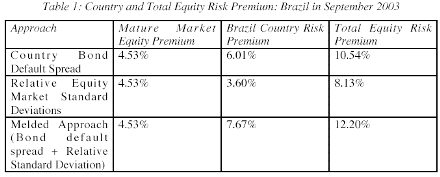The country default spreads that come with country ratings provide an important first step, but still only measure the premium for default risk. Intuitively, we would expect the country equity risk premium to be larger than the country default risk spread. To address the issue of how much higher, we look at the volatility of the equity market in a country relative to the volatility of the bond market used to estimate the spread. This yields the following estimate for the country equity risk premium.

To illustrate, consider again the case of Brazil. As noted earlier, the default spread on the Brazilian C-Bond in September 2003 was 6.01% and the annualized standard deviation in the Brazilian equity index over the previous year was 33.37%. Using two years of weekly returns, the annualized standard deviation in the Brazilian dollar denominated C-bond was 26.15%. The resulting country equity risk premium for Brazil is as follows:

Unlike the equity standard deviation approach, this premium is in addition to a mature market equity risk premium. Note that this country risk premium will increase if the country rating drops or if the relative volatility of the equity market increases. Why should equity risk premiums have any relationship to country bond spreads? A simple explanation is that an investor who can make 11% on a dollar-denominated Brazilian government bond would not settle for an expected return of 10.5% (in dollar terms) on Brazilian equity.
Playing devil’s advocate, however, a critic could argue that the interest rate on a country bond, from which default spreads are extracted, is not really an expected return since it is based upon the promised cash flows (coupon and principal) on the bond rather than the expected cash flows. In fact, if we wanted to estimate a risk premium for bonds, we would need to estimate the expected return based upon expected cash flows, allowing for the default risk. This would result in a much lower default spread and equity risk premium. Both this approach and the previous one use the standard deviation in equity of a market to make a judgment about country risk premium, but they measure it relative to different bases.
This approach uses the country bond as a base, whereas the previous one uses the standard deviation in the U.S. market. This approach assumes that investors are more likely to choose between Brazilian bonds and Brazilian equity, whereas the previous one approach assumes that the choice is across equity markets.
Choosing between the approaches
The three approaches to estimating country risk premiums will generally give you different estimates, with the bond default spread and relative equity standard deviation approaches yielding lower country risk premiums than the melded approach that uses both the country bond default spread and the equity and bond standard deviations. Table 1 summarizes the estimates of country equity and total risk premium using the three approaches for Brazil in September 2003:

We believe that the larger country risk premiums that emerge from the last approach are the most realistic for the immediate future, but that country risk premiums will decline over time.
Just as companies mature and become less risky over time, countries can mature and become less risky as well. One way to adjust country risk premiums over time is to begin with the premium that emerges from the melded approach and to adjust this premium down towards either the country bond default spread or the country premium estimated from equity standard deviations. Another way of presenting this argument is to note that the differences between standard deviations in equity and bond prices narrow over longer periods and the resulting relative volatility will generally be smaller7.
Thus, the equity risk premium will converge to the country bond default spread as we look at longer term expected returns. As an illustration, the country risk premium for Brazil would be 7.67%% for the next year but decline over time to either the 6.01% (country default spread) or 3.60% (relative standard deviation).
Note :
7 Jeremy Siegel reports on the standard deviation in equity markets in his book “Stocks for the very long run” and notes that they tend to decrease with time horizon.
Prof. Aswath Damodaran
Next: An Alternative Approach: Implied Equity Premiums
Summary: Index